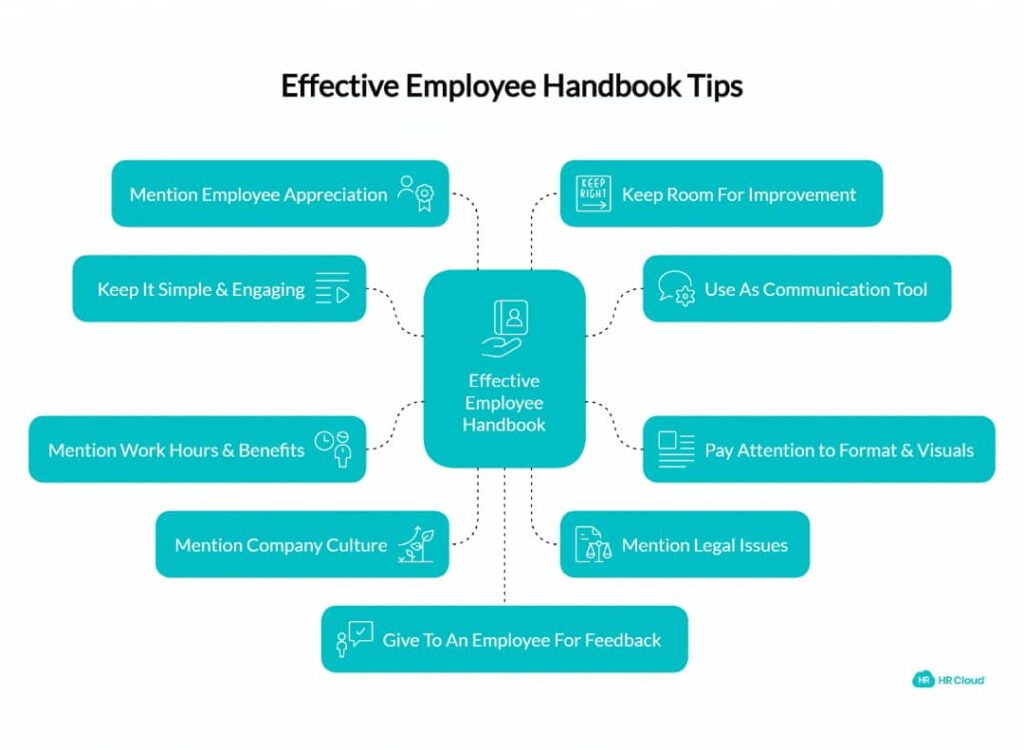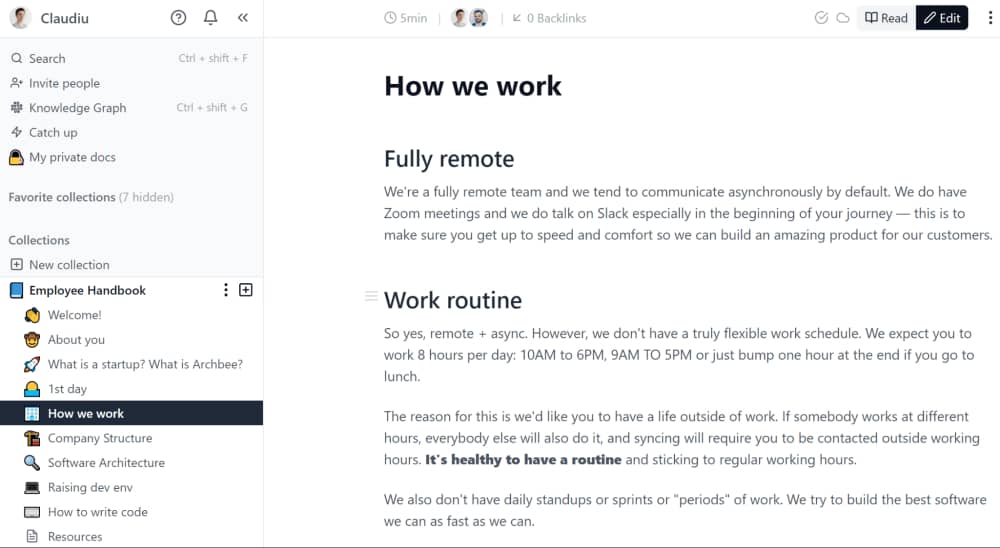
In recent years, remote work has transformed from a perk to a norm for many organisations. With this shift comes the need to clearly define how work gets done outside a physical office. That’s where an employee handbook designed for a remote team becomes critical. It helps set consistent expectations, protects both employer and employee, and anchors company culture even when people are geographically dispersed.
When employees work from home, a café or a co-working space, they don’t have the same everyday cues that an office provides – the impromptu chats, the shared physical environment, the “this is how we do it” signals. A well-crafted handbook fills that gap. It says: “Here’s how we work, remote or not.” It supports onboarding, guides performance, and helps avoid misunderstandings.
Your Remote Team Needs an Employee Handbook
A remote-specific handbook goes beyond the standard employee guide. It addresses the special challenges of distributed work and helps your team function smoothly, no matter where they’re located. Here are some of the key reasons:
First, it establishes clarity. Without a dedicated remote handbook, employees might wonder: “What hours am I supposed to be available? What tools should I use? Who do I ask for help with my setup?” A strong handbook answers these questions. For example, guidelines around hours, availability and communication tools help avoid confusion.
Second, it supports legal and compliance objectives. Remote work may span different states or countries, each with its own employment laws, data privacy rules and tax requirements. Including remote-work policies in your handbook protects you from unintended liabilities.
Third, it reinforces culture and belonging. When team members don’t share a physical space, feeling connected becomes harder. A handbook helps maintain consistent values and practices across locations.
In short, a remote team handbook isn’t optional; it’s essential for clarity, alignment and risk management.
Core Components of a Remote Team Employee Handbook

The following sections should form the backbone of your handbook. Each needs thoughtful content and remote-specific adjustments.
Company Overview and Values
Begin with your organisation’s mission, vision and values. Then show how these translate into remote work. For example, if “transparency” is a core value, explain how remote teams will practise it by documenting decisions, sharing updates and keeping communication open. Framing remote work as a strategic choice, not an afterthought, sets the right tone.
Employment Policies
This section covers employment status (full-time, part-time, contractor), probation periods, termination, anti-discrimination and equality policies. For remote arrangements, you need to address jurisdictional issues: what happens if an employee changes country, or what national laws apply. Ensuring you cover classification, contract terms, and remote eligibility is key.
Remote Work Guidelines
This is the heart of the handbook for remote teams:
- Work hours & availability: Specify whether team members must work in certain core hours or simply align with deadlines. Define response-time expectations for different tools (email, chat, video).
- Workspace setup: Explain what a suitable remote workspace looks like (quiet, reliable internet, secure access). Some companies provide equipment or stipends.
- Communication tools & etiquette: Lay out which tools are used (chat, video, email), what counts as an appropriate channel, and how quickly one should respond.
- Meeting protocols and asynchronous work: Remote teams often work across time zones. Specify when synchronous meetings are required and when async work is preferred.
- Travel or on-site requirements: If remote employees may be expected to visit an office or client site, explain how that works.
For example, an article noted that a remote work policy should cover remote eligibility, hours, tools, communication, and performance tracking.
Performance and Productivity Expectations
Remote employees need clear guidance on how their work will be measured. Is it by hours logged or deliverables completed? Make this explicit. Describe how performance reviews are handled (virtual check-ins, project tracking, one-on-ones). Remote work often needs more visible goal-setting and feedback loops to maintain alignment.
Technology, Security and Privacy
Remote environments introduce new risks. Your handbook must cover:
- Device policies: Are personal devices allowed? If yes, under what conditions?
- Security protocols: VPN use, strong passwords, approved software, and multi-factor authentication. These are critical when employees connect from home or public networks.
- Data access and privacy: rules for handling sensitive information, what can and cannot be done remotely.
- IT support: how remote employees get help and what their responsibilities are for maintaining devices or connectivity.
Compensation, Benefits and Expenses
Provide transparency about pay, benefits and reimbursements for remote employees. For example, if employees work from a country with a different cost of living, or if they need home internet reimbursement, explain how this is managed. Also cover how bonuses, promotions and raises work remotely.
Leave and Time-Off Policies
Remote employees should know exactly how to request time off, what holidays apply, and how floating holidays or global national holidays are handled. Since remote teams might operate across many countries, clarify how local holiday practices apply. It’s also important to talk about work-life balance, because remote work often blurs boundaries.
Health, Safety and Well-being
Even though employees work remotely, you still have responsibilities for the work environment and well-being. Guide ergonomic setup, breaks, mental health resources, and how to maintain boundaries between work and personal life. Remote work often increases the risk of burnout, so supporting well-being is vital.
Code of Conduct
Address professional behaviour in a remote context: tone and etiquette in chat and video, respect across cultures, conflict resolution, use of company resources, and social media use. Remote teams need the same behavioural standards as in-office teams, and possibly more clarity because miscommunication is more likely when people only interact virtually.
Communication and Collaboration Tools
Lay out which tools you use for collaboration (project management, document sharing, chat, video), how they should be used, and what the expectations are around responsiveness and documentation. Remote teams benefit from documented communication: agendas, notes, and decision logs. For example, an account on Medium emphasises “handbook-first” documentation so that decisions live in writing rather than only in chat.
Feedback and Continuous Improvement
Finally, make the handbook a living document. Encourage remote employees to give feedback, highlight handbook sections that need updating, and know how revisions will be communicated. This section should explain how updates are made and how employees signal their acknowledgement of changes.
Steps to Create a Remote Employee Handbook
Building the handbook is as important as having it. Here is a step-by-step process:
Step 1: Define goals and gather stakeholders. Bring together HR, legal/ compliance, IT, remote-team leadership and representatives. Decide what you want the handbook to achieve: better onboarding, clearer remote expectations, stronger security compliance.
Step 2: Research legal and compliance requirements. Remote work often crosses jurisdictions. Review labour laws, tax regulations, contract requirements, safety obligations and data privacy rules relevant to remote employees.
Step 3: Audit existing policies and identify gaps. Look at your current handbook or policy library and ask what applies to remote work, and what doesn’t. Use templates as a starting point.
Step 4: Draft the handbook in clear, direct language. Avoid heavy legalese. Remote employees need accessible text. Explain “why” and “how”, not just “what”. Make it practical rather than theoretical.
Step 5: Align content to company culture and remote model. If your organisation is fully remote, emphasise autonomy, asynchronous work and results. If hybrid, clarify which policies apply when remote versus in-office.
Step 6: Review with HR, legal and team leads. Ensure accuracy, relevance and consistency. Get feedback from remote team members: they know the realities on the ground.
Step 7: Design for accessibility and usability. Consider digital format (wiki, intranet, searchable PDF). Make navigation easy. Perhaps embed read-acknowledgement workflows so employees confirm they’ve read it.
Step 8: Roll out and train employees. Publish the handbook and walk through it with your team or new hires. Host Q&A sessions, highlight key sections, and ensure everyone knows where to find them.
Step 9: Maintain and update regularly. Schedule reviews, perhaps annually or after major policy/tech changes. Solicit feedback from remote employees on what works and what doesn’t.
Tools and Resources
To streamline the process:
- Use collaboration tools such as Google Docs, Notion, and Confluence, so that stakeholders can draft together and track changes.
- Use remote-work policy templates (for example, from Workable or Remote Work Advocate) to get started rather than drafting from scratch.
- Use acknowledgement platforms or internal systems so employees sign off on having read the handbook.
- Choose a format that accommodates remote work — online wiki, version control, mobile access.
- Use periodic feedback tools (surveys, check-ins) so you know if your handbook and remote policies are working.
Best Practices for Maintaining and Updating the Handbook
A handbook is not a static document; it must evolve alongside the company, its remote workforce, and technologies. Keep language simple and consistent. Use version numbers or dates so employees know they have the latest copy. When you update, communicate what changed and why. Even better, invite input from the remote team — those on the ground will spot what doesn’t work in practice. Be transparent: a revision log builds trust. Avoid making policies that are overly strict or vague. Over-rigidity may stifle autonomy; too much ambiguity will confuse.
Common Mistakes to Avoid
Many companies stumble when crafting remote-team handbooks. Here are frequent pitfalls:
- Treating the remote handbook as an afterthought or simply copying the in-office version without adaptation.
- Writing policies in vague or overly legal language that doesn’t help employees understand what they should do.
- Ignoring regional or cross-border legal issues when employees work in different jurisdictions.
- Failing to align the handbook with company culture or remote-work realities (like asynchronous time zones).
- Setting it and forgetting it: not revisiting the handbook as remote work practices change.
- Neglecting company culture, connection and wellbeing in a remote environment — forgetting that remote teams need intentional community building.
Conclusion
If you oversee a remote or hybrid workforce, an employee handbook tailored for that environment is among your most valuable tools. It declares how you work, what you expect, and how you support employees, no matter where they are. With clear structure, relevant policies, inclusive practices and regular upkeep, you create a resource that anchors your remote team.
A well-crafted handbook builds trust, clarity and alignment. It reflects your culture, supports your people and gives you peace of mind. As remote work continues to evolve, so too should your handbook. Think of it as a living guide — one that you revisit, refine and use to unite your distributed team under one shared standard.
FAQ Section
Q: How often should you update a remote employee handbook?
A: At least annually or whenever there’s a major change in law, business model or remote-work practice. More frequent reviews are wise if you operate across many jurisdictions.
Q: What format is best for distributing a remote handbook?
A: It depends, but commonly a digitised version (PDF) hosted on your HR-portal or intranet, plus an editable version for internal review, is ideal. Make sure it’s easy to access from anywhere and on any device.
Q: Can I use a generic handbook template for remote work?
A: You can start with a template, but you must customise it to reflect your team’s remote practices, your jurisdictional requirements and your company culture. Generic templates often miss remote-specific issues.